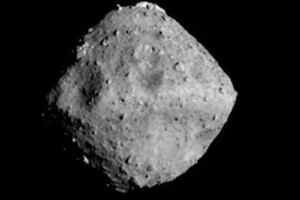More than 20 amino acids were found on the surface of the asteroid Ryuga.

Scientists for the first time managed to find “building blocks of life” on an asteroid in space. More than 20 amino acids have been found on the asteroid Ryuga, which is located 320 million kilometers from Earth, according to Science Alert.
Scientists made the first discovery of their kind thanks to samples delivered to our planet by the station “Hayabusa-2”, which touched the surface of the asteroid in 2019. She then collected 5.4 grams of matter from the celestial body and placed them in a special container that was delivered to Earth.
Read also: Samples of the asteroid Ryuga contain the oldest material ever studied by scientists
>
Ryugu is not a monolithic “stone”, but rather consists of many small stones. It is likely that they formed from the same nebula as the Sun and the planets of our system. Previous research on Ryuga samples has shown that it may contain water.
Unlike the organic molecules discovered by the Earth, the carbon-black samples of the asteroid Rugu, which reflect only 2-3% of the light reaching them, have not been altered due to interactions with the environment of our planet. This makes them close to the early solar system.
“We found various prebiotic organic compounds in the samples, including proteinogenic amino acids, polycyclic aromatic hydrocarbons similar to petroleum, and various nitrogen compounds. These prebiotic organic molecules may be spreading throughout the solar system, possibly in the form of interplanetary dust rising from the surface of Ryuga due to impact or other causes, “said Hiroshi Naraoka, a planetary scientist at Kyushu University.
10 types of amino acids have been found in asteroid samples, but now this number has increased to 20. Amino acids are the fundamental building blocks of all proteins and a necessary condition for the origin and existence of life on our planet.
A study conducted in 2019 found organic molecules from space in a 3.3 billion-year-old rock from South Africa. This increases the likelihood that some, if not all, of the molecules needed to make life were brought to Earth by comets and asteroids. The discoveries made in the study of Ryug's samples once again confirmed this hypothesis.
It is likely that organic molecules can be found on other planets, as well as their satellites. This may indicate that life may have originated in more places in the universe than previously thought.
Scientists continue to analyze samples of the asteroid Ryuga and further intend to provide other data obtained from such studies. and return to Earth . At that moment, she was at a distance of 20.11 kilometers from the surface of the asteroid. Fifteen minutes later, the mission team received a signal that the maneuver was successful.
On December 6, 2020, the station dropped a capsule with soil samples of the asteroid Ryuga. On December 15, experts opened section A of the capsule and found soil in it, which is believed to have been collected during the first rapprochement with Ryuga in February 2019.
equipment is working, scientists have decided to continue its research program. The main target of the station was a 30-meter near-Earth asteroid 1 998 KY26. In July 2026, the station will fly near an additional target – a 700-meter asteroid 2001 CC21.




